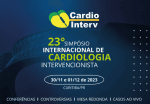The initial strategy for the treatment of patients at high risk of bleeding (HBR) after percutaneous coronary intervention (PCI) has consisted of a short dual antiaggregation therapy (DAPT). Stents continue to improve, which has allowed the reduction of DAPT schemes and therefore the incidence of bleeding. However, researchers are also looking into another strategy to...
CAPTIS, a Novel Cerebral Embolic Protection System in TAVR
The incidence of stroke after TAVR ranges between 2 and 5%, depending on the series, which has been associated with higher morbimortality, affecting patient quality of life and their psycho-social environment. Many cerebral embolic protection systems have been developed in response, and even though they have been shown beneficial in many studies, their role in...
AHA 2023 | MINT: Liberal vs Restrictive Transfusion in Patients with Acute Coronary Syndrome
The aim of this study was to assess hard end points such as death or MI in patients with acute coronary syndrome (ACS) presenting hemoglobin levels lower than 10 mg/dl. It was a randomized multicenter double blind trial including 3506 participants. The study looked at different transfusion strategies, comparing restrictive strategy with 7-8 g/dl hemoglobin...
AHA 2023 | SELECT Trial: Semaglutide in Patients Without Diabetes
Given the obesity pandemic projected for the year 2035, it is imperative to address this disease as a priority, through well-known hygienic-dietary measures and the use of drugs that have shown promising results. Obesity has been identified as an independent cardiovascular risk factor, even after modifying risk factors associated with diabetes. Semaglutide, a GLP-1 agonist,...
AHA 2023 | ORBITA-2: PCI vs. Placebo in Stable Angina for Symptom Reduction
In patients with stable chronic angina, percutaneous coronary intervention (PCI) is often conducted to relieve symptoms. However, there is still some uncertainty regarding whether PCI provides superior symptomatic relief compared with a placebo in patients not receiving anti-anginal medication. Researchers conducted a controlled and randomized study in which patients with stable angina discontinued all anti-anginal...
AHA 2023 | Use of Apixaban for Stroke Prevention in Subclinical Atrial Fibrillation
Subclinical atrial fibrillation (AF), generally asymptomatic and of short duration, often requires continuous long-term monitoring using pacemakers or defibrillators for its detection. While subclinical AF is linked to an increased risk of stroke, the usefulness of oral anticoagulation as a treatment remains uncertain. In a double-blind randomized trial, one group received apixaban and the other...
Untreated Aortic Stenosis: Associated Mortality and a Call to Attention
The progression of aortic stenosis has been extensively studied and is well-known. As observed, in its advanced stages, this condition entails high morbidity and a marked decrease in survival. Both North American and European guidelines recommend treatment when faced with severe valve disease. However, true severity can be difficult to determine due to discordant data,...
Cardiointerv 2023 Soon to Be Held
The Latin American Society of Interventional Cardiology is inviting our entire community to take part in Cardiointerv 2023, to be held November 11 thru December 1. The event will be featuring a world class scientific program, prestigious international guests and challenging live cases. CardioInterv 2023 has the institutional support of SOLACI.
Cerebral Embolic Protection Devices: How Useful are they in TAVR?
During TAVR, we often fear the possibility of a stroke, which occurs in approximately 1 – 2% of cases. In general, this phenomenon is caused by thrombi stemming from atherosclerotic or calcified plaque, depending on the etiology. Even though its incidence has declined with technology development and the increasing expertise of operators, it is still...
Is TAVR Beneficial in Cardiogenic Shock?
The presence of cardiogenic shock (CS) in a setting of aortic stenosis ranges from 1% to 4%. The prognosis for this scenario is ominous due to subendocardial ischemia, which presents as a decrease in ventricular preload and an increase in afterload. Aortic valvuloplasty has been used in this context, but, unfortunately, it has been associated...






